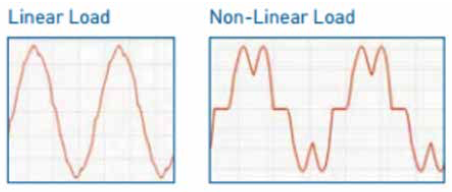An Overview of Harmonics in Electrical Systems
What are harmonics?
In an electric power system, a har- monic is a voltage or current at a multiple of the fundamental frequency of the system. Harmonics can best be described as the shape or characteristics of a voltage or current waveform relative to its fundamental frequency. When waveforms deviate from a sin- ewave shape, they contain harmon- ics.
Harmonic frequencies in the power grid are a frequent cause of power quality problems, resulting in increased heating in the equipment and conductors, misfiring in variable speed drives and torque pulsations in motors.
What causes harmonics?
AC electrical loads are referred
to as either linear or non-linear, depending on how they draw current from the mains power supply wave- form. With a linear load, the relationship between the voltage and cur- rent waveforms are sinusoidal and the current at any time is proportional to the voltage; this is known as Ohm’s law. Examples of linear loads include transformers, motors and ca- pacitors.
With a non-linear load, the current is not proportional to the voltage and fluctuates based on alternating load impedance, meaning the current it draws does not have the same wave- form as the supply voltage. Non-linear loads draw currents in abrupt short pulses.These pulses distort the current waveforms, which in turn generates harmonics that can lead to power problems affecting both the distribution system equipment and the loads connected to it. Examples of non-linear loads include rectifiers, variable-speed drives and electronic devices like computers, printers,TVs, servers and telecom systems that use switched-mode power sup- ply (SMPS) power conversion technologies.
What are the consequences of harmonics?
A power system’s ability to per- form at optimal levels is compromised when harmonic distortion enters the system. Harmonics create inefficiencies in equipment operations due to the increased need for power consumption. The increase of overall current required creates higher installation and utility costs, overheating and decreased profitability.
How can you reduce harmonics?
A few of the most popular ways to control harmonics include:
1.Trying to reduce the harmonic currents produced by the load. Adding a line reactor or transformer in series will significantly reduce harmonics, as well as provide transient protection benefits.
2. Adding filters to either siphon the harmonic currents off the system,
thereby blocking the currents from entering the system in the first place, or supply the harmonic currents locally. For example, adding a shunt filter short-circuits harmonic currents as close to the source of distortion as practical. This keeps the currents out of the supply system.The shunt filter is a popular filter choice because it is cost-effective and can correct the load power factor while also removing the harmonic current.
3. Modifying the frequency response of the system with filters, inductors or capacitors. Active filters work by electronically supplying the harmonic component of the current into a non-linear load.
4. Providing transformer connections, which can reduce harmonic currents in three-phase systems.
5. Changing the capacitor size.This is often one of the least expensive options for both utilities and industrial customers.
Having issues with harmonics? Visit anixter.com/contact to get help from one of our expert electrical engineers.































































